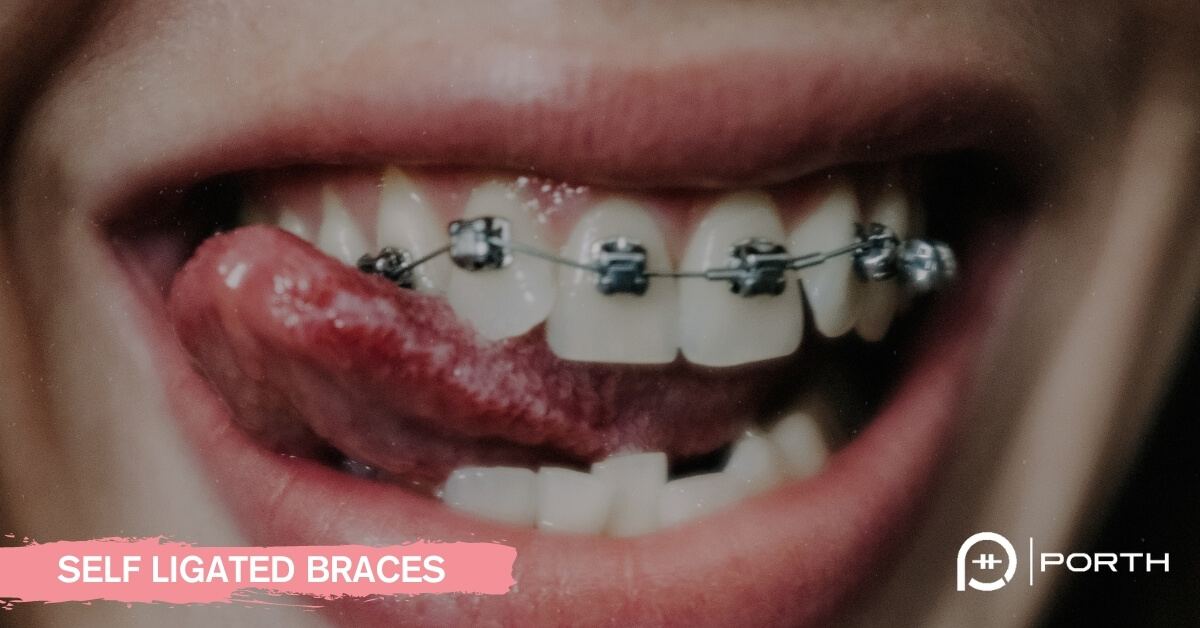Table of contents
- What Are Self-Ligating Braces?
- How Do Self-Ligating Braces Work?
- The Cost of Self-Ligating Braces—Are Self-Ligating Braces More Expensive?
- The Benefits: What Are the Advantages of Self-Ligating Braces?
- The Cons: Why Self-Ligating Braces May Not Be Right for You
- What’s the Difference Between Self-Ligating Braces and Traditional Braces?
- Self-Ligating Braces Are Worth It!
In recent years, self-ligating braces like the Damon braces system have become a choice from various types of braces for orthodontic patients.
Now, you’re wondering: “could self-ligating braces be right for me?”
How do self-ligating braces work? Are self-ligating braces better than traditional orthodontic treatments? What about lingual self-ligating braces? Lingual or hidden braces are a cosmetic version of metal braces.
Self-ligating braces could end up being the most comfortable way to straighten your teeth, so they are definitely a solution worth considering.
In this article, we’ll give you the facts about self-ligating braces and answer your questions so that you can make a smart decision about your treatment.
What Are Self-Ligating Braces?
Self-ligating braces, sometimes called “self-ligating brackets,” are braces that don’t require elastic ties, also known as ligatures, to hold the archwire in place. Ligatures are typically the small, colored rubber bands used with traditional braces treatment to secure the archwire within the brackets.
Unlike traditional braces, self-ligating braces have specially designed brackets that allow the archwire to move freely, eliminating the need for manual tightening. Digital braces can be self-ligated braces type. This design accommodates natural tooth movement more efficiently without the use of elastic bands.
There are various claims surrounding self-ligating braces, such as fewer adjustment appointments, faster treatment times, gentle pressure, and an improved sliding mechanism. However, many of these claims remain unproven.
How Do Self-Ligating Braces Work?
While traditional metal braces require periodic adjustments to move teeth into place, self-ligating braces work a bit differently to fix dental issues.
Like traditional metal brackets, self-ligating braces rely on the pressure of an archwire to move teeth. However, instead of being secured by rubber bands or stainless steel ties, the brackets in self-ligating braces have built-in sliding mechanisms.
Special clips enable the orthodontist to easily open the brackets for archwire adjustments.
There are two types of self-ligating braces:
- Passive self-ligating braces: The archwire moves freely through passive brackets without applying additional pressure.
- Active self-ligating braces: The brackets feature small springs that apply a light, continuous pressure on the archwire to guide teeth into alignment.
Although you will still need periodic follow up appointments with your orthodontist, the check-ups tend to be less frequent.
Yes! Self-ligating braces are an effective option for straightening teeth without the need for rubber bands, offering a comfortable alternative to traditional braces.
They are an excellent choice for anyone seeking orthodontic care that minimizes color ties while delivering a healthy, beautiful smile.
As with any type of braces, you may experience some initial discomfort as your teeth adjust to the treatment. Self-ligating braces similar to other braces come with slight tenderness.
Some self-ligating braces wearers do actually notice a dramatic difference in their tooth alignment early in their treatment. This is fairly common with other orthodontic treatments, however, and it doesn’t mean that self-ligating braces take less time than regular braces.
Current studies show that there is no difference in treatment time when comparing regular braces with self-ligating ones. On average, treatment with either method takes about 12 to 24 months.
Self-ligating braces are meant to work with your natural tooth movement process, not rush it. Your teeth will move as quickly as they want to, and self-ligating braces can help you get a straighter smile in greater comfort.
No, self-ligating braces don’t require manual tightening. The brackets are designed to adjust naturally as your teeth shift, so you won’t need frequent tightening appointments. However, you will still have regular checkups with your orthodontist to monitor your progress.
During these visits, the orthodontist may replace your archwire or adjust the pressure based on your treatment needs, which could involve correcting issues like an overbite or improving the appearance of your smile.
Once your treatment with self-ligating braces is complete, your orthodontist will likely recommend wearing a retainer to maintain your new smile. Whether you choose clear braces (self-conscious patients) or traditional metal braces, a retainer is essential for preventing your healthy smile from shifting back to their original position.
Yes, there are various types of lingual braces, and some do feature self-ligating metal brackets. These self-ligating lingual braces offer the benefits of reduced friction and fewer adjustments while remaining hidden behind the teeth. Lingual braces are an excellent choice for patients who want a discreet treatment option but aren’t interested in clear aligners.
The Cost of Self-Ligating Braces—Are Self-Ligating Braces More Expensive?
The cost of self-ligating braces typically ranges from $2,000 to $7,000. As with any orthodontic treatment, the total braces cost depends on several factors, including the duration of treatment, the spacing between your teeth, and whether you have conditions such as a crossbite or other forms of malocclusion.
Self-ligating braces may be slightly more expensive than traditional braces due to the use of advanced treatment planning technology. However, insurance plans may help cover a portion of the cost, making orthodontic care more accessible to a wider range of patients. It’s essential to review your insurance terms to understand what is covered and ensure your treatment fits within your coverage.
For those without insurance, many providers offer flexible payment options to improve accessibility and make achieving a beautiful, healthy smile more affordable. Always check the specific terms of your payment plan to ensure it aligns with your financial needs.
The Benefits: What Are the Advantages of Self-Ligating Braces?
There are some good reasons why you should seriously consider getting self-ligating braces to straighten your teeth.
More comfort
Self-ligating braces move your teeth gently without applying intense pressure on your teeth. This makes them much more comfortable than regular braces that are tightened and held in place with rubber bands.
Shorter and fewer appointments
With no rubber ligature bands to remove and replace, your adjustment appointments for self-ligating braces will take much less time. You also won’t need to have orthodontic checkups as frequently as you would with regular braces.
Easier oral hygiene
Without rubber bands or metal ties wrapped around your brackets, you’ll find that flossing and brushing are much easier. Improved oral hygiene can lead to improved oral health, which is the key to successful orthodontic treatment.
One advantage of self-ligating braces is that they don’t require elastic ties, which can trap food particles and plaque. Additionally, both clear and stainless steel braces can feature self-ligating technology. If you’re concerned about aesthetics, you can still choose colored ties for your self-ligating braces to enhance your smile’s appearance.
The Cons: Why Self-Ligating Braces May Not Be Right for You
Self-ligating braces aren’t the perfect orthodontic solution for everyone. It’s good to know the downsides so that you know exactly what to expect and can choose the teeth-straightening method that’s best for you.
Higher cost
Although there isn’t always a big difference between the cost of regular braces and self-ligating braces, every cent counts for those who are trying to save money. If you need to choose the cheapest orthodontic treatment, then self-ligating braces are probably not right for you.
Visibility
Self-ligating brackets are much less visible than traditional brackets because they don’t have colored rubber bands. But they are still noticeable on teeth, so if visibility is a concern for you, then you might want to choose an alternative like clear brackets, Invisalign, or another type of clear plastic aligners.
Risk of decay
As with any other orthodontic appliance, there’s always an increased risk of tooth decay if you don’t practice excellent oral hygiene. When you have an archwire and brackets attached to your teeth, they provide places for cavity-causing plaque bacteria to grow. If you already have a high risk of tooth decay, then a removable orthodontic appliance may be best for you.
Of course, it’s good to note that self-ligating braces can actually lower your risk of tooth decay in comparison with braces because they are easier to clean.
What’s the Difference Between Self-Ligating Braces and Traditional Braces?
Now that we’ve covered the basics of self-ligating braces, we can compare them alongside regular metal braces.
| Self-Ligating Braces vs. Traditional Metal Braces | ||
| Self-Ligating Braces | Conventional Braces | |
| Less discomfort | ✔ | |
| Cheaper | ✔ | |
| Treatment time | 12–24 months | 12–24 months |
| Needs tightening | ✔ | |
| Requires visible elastic ties | ✔ | |
| Shorter orthodontic visits | ✔ | |
| Fewer orthodontic appointments | ✔ | |
| Less visible | ✔ | |
| Easier to clean | ✔ |
Self-Ligating Braces Are Worth It!
If you’ve been wondering whether self-ligating braces are right for you, then this could be your sign. Self-ligating braces work wonderfully well and they offer some special advantages over traditional metal braces. They aren’t necessarily faster or cheaper than regular braces, however.
Now that you know all the pros and cons, you’re ready to book a consultation with an orthodontist near you to find out if self-ligating braces are the best type of orthodontic appliance for you.
If you live in the Sammamish or Bellevue areas, then plan a visit to or book a virtual consultation with PORTH to explore your orthodontic treatment options.



